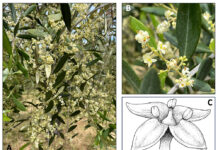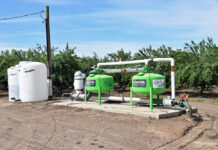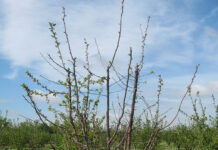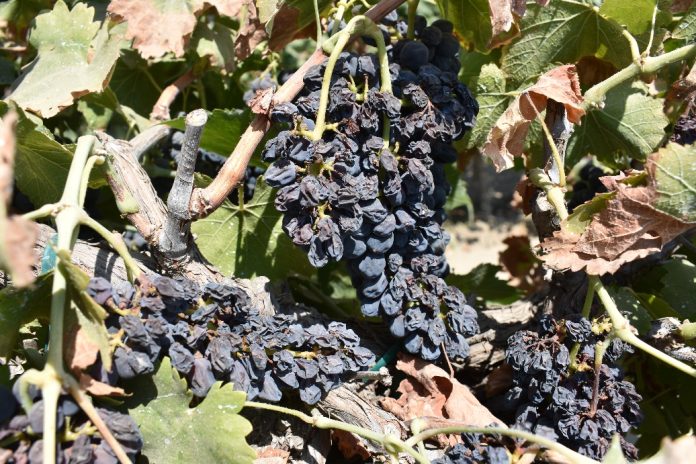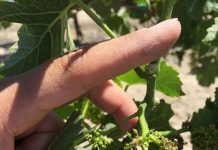Heat waves with extreme daily temperatures are becoming more and more common in the San Joaquin Valley (SJV) during the middle of growing season, e.g., July and August. In 2017, grape growers in the SJV have experienced two to three weeks with maximum daily temperature ≥ 110 °F. Sunburn with the associated severe water stress have resulted in significant yield loss and poor berry quality at harvest. Berry sugar, organic acids, anthocyanins, and phenolics all can be impacted by extreme daily temperature. Sugar accumulation can be significantly affected since the leaf photosynthetic rate starts to decrease when the canopy temperature passes 30 °C. Under high berry temperature (≥ 30 °C), the degradation of organic acids start to accelerate as well as anthocyanins and phenolics.
Water Stress
When the heat wave occurs, it usually also causes grapevine water stress due to the need of evaporative cooling in order to lower the canopy temperature. High daily temperature coupled with severe water stress will eventually reduce the berry size and ultimately make the berry shrivel and raisin (Figure 1). Several vineyard practices can be adopted by growers to alleviate the potential damage from the heat wave and reduce the yield loss as well as the degradation of berry composition:
- Row orientation
- Trellis selection
- Variety selection
- Canopy management
- Irrigation scheduling
- Canopy shading
- Canopy cooling

Row Orientation
The optimum row orientation in the SJV is southwest to northeast with approximately 45° angle to have the equal sunlight exposure on both sides of the canopy. The traditional row orientation of raisin vineyard in the SJV of east to west is still good to minimize the direct light exposure on fruit-zone. North to south row orientation should be avoided for sunburn susceptible varieties, e.g., Muscat of Alexandria and Chardonnay.
Trellis Selection
Trellis selection is as important as row orientation. Vertical shoot positioning trellis is usually not suitable in the SJV due to the excessive light exposure on fruit-zone. Two-wire vertical trellis, or “California Sprawl”, is the most common and yet suitable for the SJV. Any trellis with a sprawling system is preferred under the hot climate.
Varieties
Variety evaluation has been on-going in University of California (UC) Kearney REC for a couple of years and the initial data has confirmed that certain varieties from southern Mediterranean regions can tolerate the heat and produce the decent yield and berry composition. Some varieties, e.g., Fiano, are under commercial test to further prove their suitability under the SJV’s hot climate. However, the adoption of alternative varieties might largely depend on marketing and consumers’ acceptance.

Canopy Management
Canopy management, e.g., shoot thinning and leafing, is applied to provide enough light exposure and air circulation on fruit-zone without exposing the clusters to too much direct sunlight. Hand or mechanical leafing (Figure 2) can be applied only on the “morning” side of the canopy to avoid the afternoon sunlight exposure on fruit-zone.
Irrigation Management
Irrigation management might be the most critical and powerful tool for growers and the appropriate irrigation scheduling can be applied to avoid excessive heat damage/water stress as well as berry sunburn. Severe deficit irrigation should be avoided before the heat wave occurs to make sure vines with no or minimal water stress under the extreme daily temperature. Soil moisture sensor, pressure chamber, or basically by feel and appearance can help growers to assess soil moisture and vine water status, or growers can simply follow the grape evapotranspiration (ET) report (https://ucanr.edu/sites/viticulture-fresno/Irrigation_Scheduling/) to decide the amount of irrigation per week to avoid severe grapevine water stress during the heat wave.
Canopy Shading
Canopy shading including shade cloth (Figure 3) and sun protectant, e.g., Kaolin and CaCO3 (Figure 4), can be used to shade the canopy and fruit to avoid excessive light exposure and sunburn. Cost and timing might be the most important factors when growers decide to use shade cloth and sun protectant. Generally, the optimum timing to apply canopy shading is after berry set or several days before the heat wave.
Canopy cooling can also be applied by in-canopy misting. Studies in Australia have found by in-canopy misting it can cool canopy and clusters by several degrees, and ultimately improve yield and berry composition during the heat wave (https://www.wineaustralia.com/research/search/completed-projects/ua-1502).

Integrated Approach
Finally, it might require to take the integrated approach by using more than one mentioned strategies to maximize the production and berry quality during the heat wave. Growers should consult local farm advisors and conduct the small trials to evaluate the effectiveness of different approaches under the local condition.


